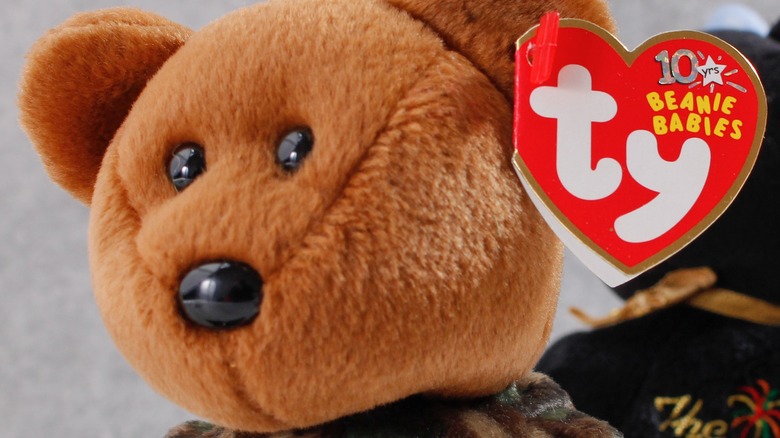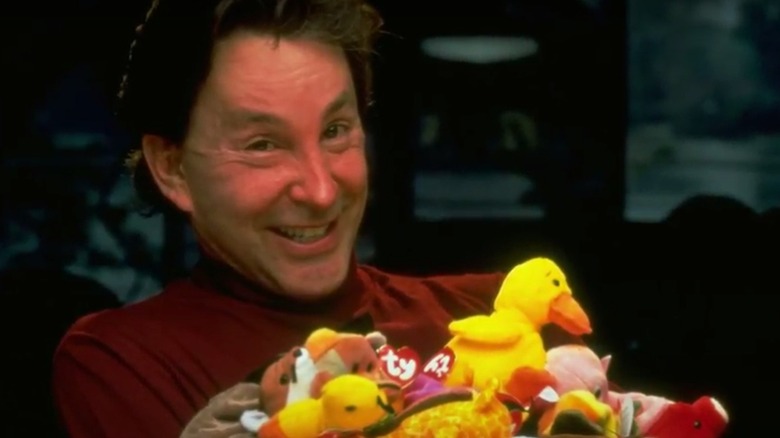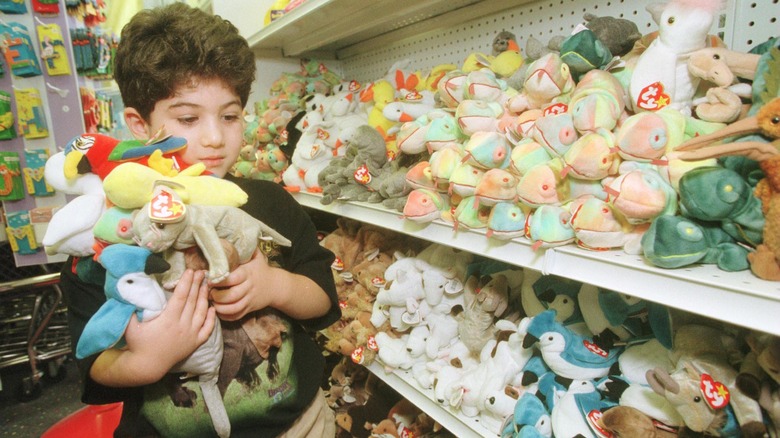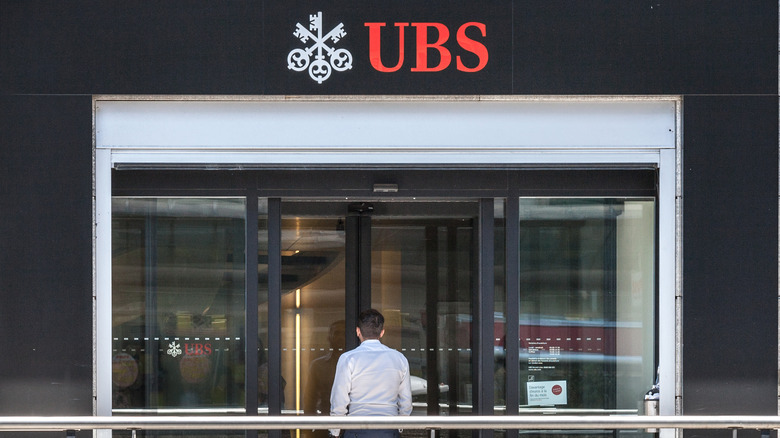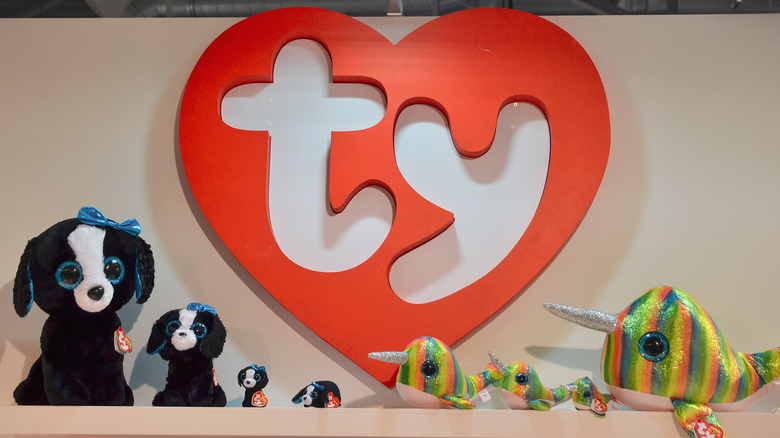The Shady Side Of Beanie Baby Billionaire Ty Warner
If you owned a Beanie Baby in the '90s, chances are you — or someone you were close with — saw that precious plush Hacky Sack as an investment in the future. Released in limited batches with adorable backstories written within their bright red, heart-shaped tags, Beanie Babies created a national frenzy that spilled out of the toy world and into the economy.
People were certain that these PVC-pellet-filled creatures would go for hundreds, possibly thousands of dollars one day. Emboldened by a weak economy and the nascent Internet, individuals who didn't have the patience to wait for their speculative payout began using eBay to sell their $5 Beanie Babies for thousands of dollars, according to The Fiscal Times.
But as we all know now, it was a sham, a too-good-to-be-true fever dream in which some people believed American commerce would involve bright red dogs and tie-dye teddy bears. The lucky ones moved on with their lives, re-homing their Beanie Babies to plastic bins in the garage. The unlucky ones ended up holding the bag once the Beanie Baby bubble burst. Some lost upwards of $100,000, like the family at the center of the documentary "Bankrupt by Beanie Babies" (per ABC News in 2013).
Everyone knows that Beanie Babies were an embarrassing bust; a wool, knitted with sleek marketing and emotional manipulation, pulled over our eyes. However, there is one inscrutable man who really did make a lot of money off Beanie Babies: H. Ty Warner, the mysterious sole owner and creator of Beanie Babies.
A theater nerd starts selling toys
Despite the fact that his name is plastered in gummy white letters on every single Beanie Baby, Ty Warner (per Chicago Magazine) is an enigma. What is known about the elusive toy man largely comes from one, in-depth interview he did with People magazine in 1996.
Up until his creation of the Beanie Babies line, Ty Warner (above) had a relatively unimpressive life. Sure, he had a strained relationship with his parents, but what kind of arcane billionaire doesn't? Hailing from the Midwest, Warner was known as a good student before dropping out of Kalamazoo College due to financial strain. With a penchant for the stage, he decided to use his newly cleared schedule as an opportunity to move to Hollywood to pursue acting — ironic for a man who is now shrouded in mystery. After five years of working odd jobs with no acting leads, Warner moved back to the Midwest, where his father, who happened to be in the toy business, got him a job at Dakin Toy Company.
At Dakin, Warner developed a reputation for being a bizarre but talented salesman. Known for showing up in elaborate outfits, including fur coats and top hats, Warner told People, "I figured if I was eccentric looking in Indiana, people would think, 'What is he selling?'" As Warner's confidence grew, so did his hubris, and soon he made plans to launch his own toy company.
Beanie Baby madness takes over America
According to the Chicago Magazine profile on Ty Warner's downfall, after 10 years with the Dakin Toy Company, Warner was unceremoniously fired when he was caught selling his own plush toys to Dakin customers. This firing ended up being the push Warner needed to really set out on his own. Early on in his entrepreneurial adventures, Warner made a handful of brilliant business decisions that took Beanie Babies from a cute toy to a nationwide phenomenon.
For starters, he under-stuffed the toys he created. On the surface, this doesn't seem like a needle-moving decision, but it helped set Beanie Babies apart from other stuffed toys. "At first everyone told me I was cheap," Warner told Joni Blackman (via West Suburban Living), the only reporter to ever get him to talk. "They didn't get it. The whole idea was it looked real because it moved."
Second, his uniquely reasonably priced Beanie Babies were released in limited numbers to create deliberate scarcity. No one knew when a particular Beanie Baby might disappear off shelves forever. Zac Bissonnette, the author of "The Great Beanie Baby Bubble," told Chicago Magazine, "[Beanie Babies] just never seemed as ubiquitous, because he was limiting each store to 36 of a style. That's actually why they were able to work as a collectible: People just had no idea how many of them he was shipping."
But soon, Warner would make a costly decision. It would mar his reputation and result in potential jail time.
Beanie Baby empire built on a weak foundation
As the Beanie Babies craze reached astronomical levels, so did Ty Warner's bank account. This is where the mystery man made a decision that would come back to haunt him 12 years later.
In 1996, three years after launching Beanie Babies, Warner flew to Zürich, Switzerland to set up an account with UBS, an enormous Swiss investment bank (per Chicago Magazine). The account was to be kept secret so that Warner could stash his millions, unbeknownst to his own accountants and more importantly, the U.S. Government. Thanks to his shady dealings, Warren's money could now accrue interest, tax free, for as long as he pleased ... or until he was caught. Unfortunately for Warner, it was the latter that ended up coming to fruition.
In 2008, Department of Justice and the Securities and Exchange Commission targeted UBS in a crackdown on secret off-shore bank accounts. It was only a matter of time before Ty Warner's scheme came crumbling down around him.
Ty Warner receives a slap on the wrist
As Forbes reported in 2015, by the time Ty Warner was caught, he had squirreled away more than $100 million in his secret Swiss bank account. Warner was found guilty of his crimes and, in 2014, sentenced to two years' probation, 500 hours of community service, and given a $100,000 fine on top of paying $80 million in penalties. A slap on the wrist considering how long he had been defrauding the IRS. According to the United States Attorney's Office, Warner's rap sheet included failing to report $24.4 million in income and evading $5.6 million in federal taxes. To put that in perspective, Celebrity Net Worth reports that Warner is worth $3 billion, and is the largest taxpayer in Santa Barbara County, California.
Who would've thought that the man who stirred up the American public into a state of hysteria over a collection of velveteen toys would have an unsound, manipulative business sense. This is a good reminder that while it's okay to bring back the bucket hats and crop tops, we should probably leave the Beanie Baby craze in the '90s where it belongs.
